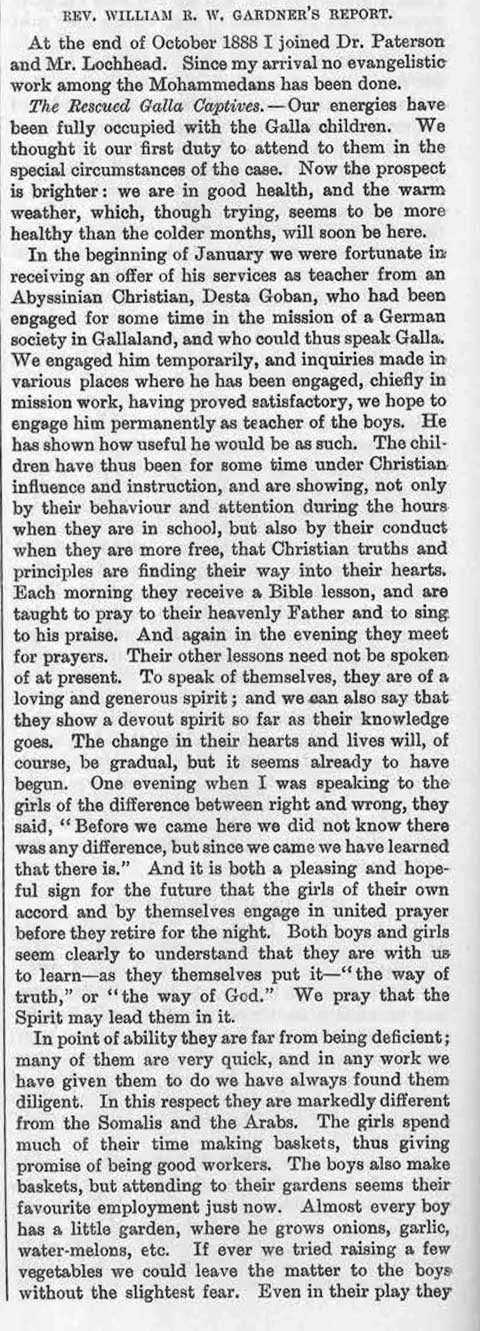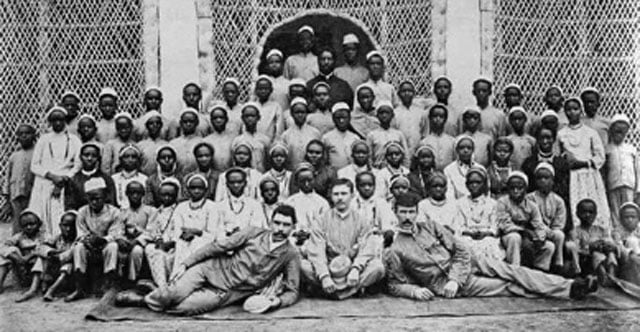Introduction
The Keith-Falconer Mission in Shaikh Othman near Aden (Yemen) received two groups of Oromo children who were freed from slavers’ ships at the end of 1888 resp. in summer 1889. Their instructors at the new mission school included Gebru Desta and Rev. Gardner. Since one fifth of the children died of malaria, the Oromo children were sent to the Lovedale Institution in the Easter Cape (Republic of South Africa) in July 1890.
Twenty years later, 21 of the liberated Oromos had returned to Ethiopia. Gebru Desta, who had lobbied the Ethiopian government for their repatriation, also played a role in this.
Annual Report by Rev. Gardner (Shaikh Othman, 1889)


Notes on the Report
“Each morning they receive a Bible lesson, and are taught to pray to their heavenly Father and to sing to his praise.”
- Gebru Desta had held house services in Balli in the 1880s. It is therefore likely that he also prayed and sang with the children in Afaan Oromoo in Shaykh Othman. It is not yet possible to draw firm conclusions about the songs.
- Onesimos’ hymnal appeared in 1886, which is too late to have been used in Balli. However, Gebru Desta knew the Swedish mission station in Eritrea from travelling, so perhaps he had learned a few Oromo gospel songs there. — Anyhow, a few months after school started in Shaikh Othman, some Oromo hymnals probably arrived from Eritrea.
- In view of Gebru Desta’s long stay in St. Chrischona and his years of missionary work in the areas of Gondar and Ankober (under the supervision of Flad and Johannes Maier respectively), it can be assumed that a large part of the Oromo songs were translations of the songs used in St. Chrischona during the 1870s. These hymns can be found in particular in Knapp’s Evangelischer Liederschatz [Treasure trove of Protestant songs] and Hiller’s Geistliche Lieder [Spiritual songs].
- Gebru Desta met the leader of the Protestant community in Jiren, Niguse Tashu, in Aden in 1890. Niguse held house services in Oromo. However, it is unknown what kind of gospel songs they used since there were almost no reports.
- In 1894, the Lovedale Missionary Institution printed a booklet with hymns etc. for their Oromo-speaking students. Four years after the departure from Sheikh Othman, several songs had probably been translated from the Free Church of Scotland’s hymn book, the Free Church Hymn Book.
“two [Oromo] books printed about 1845”:
- These are Krapf’s Imperfect Outline (1840) and Vocabulary (1842). [View online]
“more books from the British and Foreign Bible Society [BFBS] and the Swedish Misson at Massowah”
- In 1889 the BFBS had an Oromo version of the New Testament and some books of the Old Testament in stock (translated by Ludwig Krapf and his team). The Lovedale Missionary Institution printed a Roman script edition of the Gospel of Mark in 1893.
- The only book in the Oromo language that the Swedish Mission had printed by 1889 was Onesimos Nesib’s hymnal, Faarsaa fi Weedu (1886).
Picture
1890:

(Gebru Desta: centre back; William Gardner: centre front).
Adapted from fig. 8.7 in Shell, Children of Hope.
Hymnal
Read about the Oromo hymnal published in Lovedale in 1894:
- Galla Hymns, and graces, the Ten Commandments, the Apostle’s Creed, the Lord’s Prayer, and verses. Lovedale (Easter Cape Province, RSA): Lovedale Mission Press, 1894. [12p]
Transcribed Gospel
Read about the Oromo gospel published in Lovedale in 1894:
- The Gospel According to St. Mark. Lovedale (South Africa): Mission Press, 1893.
Further Reading
Arén, Gustav. Evangelical Pioneers in Ethiopia: Origins of the Evangelical Church Mekane Yesus (Studia Missionalia Upsaliensia 32). Stockholm (Sweden): EFS förlaget; Addis Ababa: Evangelical Church Mekane Yesus, 1978. [On Niguse Tashu, see esp. p. 269-70; view online].
Shell, Sandra Rowoldt. Children of Hope: The Odyssey of the Oromo Slaves from Ethiopia to South Africa. Athens: OH: Ohio Univ. Press, 2018. [See index, s.v. Liban Bultum; Google Books]